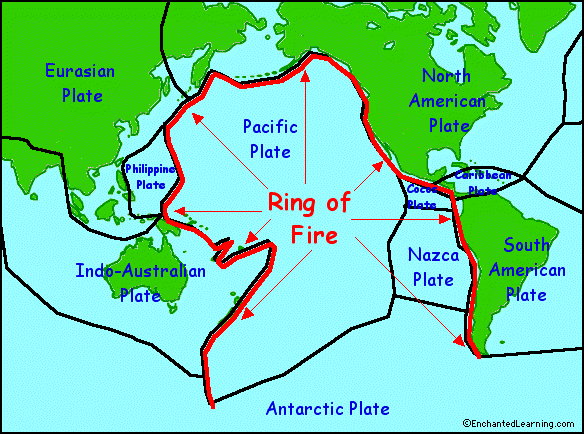A volcano is a landform usually a mountain, where melted molten rock called lava erupts through the opening at the earth’s surface. There are about 1510 active volcanoes in the world! About 90% of the world’s volcanoes arise in the pacific ring of fire. When the molten rock is below the earth’s surface it is called magma but when it emerges to the earth surface it is called lava. The name volcano comes from the name Vultan which means god of fire in Roman mythology. An eruption begins when pressure in the magma chambers from plates colliding forces the magma up through the conduit and out one of the volcanoes vents. The type of the eruption partly depends on the amount of gases and silica in the magma. The amount of silica determines how sticky/ level of viscosity the magma is and the water provides the explosive potential of steam. The amount of water and silica determines how vicious the volcanoes is e.g.: low water, low silica - runny lava flows (not viscous) where as low water, high silica (very viscous) - pasty lava. Most eruptions are more ash than lava and although most people think that the lava takes most of the victim’s lives from volcanic eruptions it’s actually the ash suffocating the people that kill most of them.
Geography of Natural Disasters
Thursday 17 May 2012
Volcano
A volcano is a landform usually a mountain, where melted molten rock called lava erupts through the opening at the earth’s surface. There are about 1510 active volcanoes in the world! About 90% of the world’s volcanoes arise in the pacific ring of fire. When the molten rock is below the earth’s surface it is called magma but when it emerges to the earth surface it is called lava. The name volcano comes from the name Vultan which means god of fire in Roman mythology. An eruption begins when pressure in the magma chambers from plates colliding forces the magma up through the conduit and out one of the volcanoes vents. The type of the eruption partly depends on the amount of gases and silica in the magma. The amount of silica determines how sticky/ level of viscosity the magma is and the water provides the explosive potential of steam. The amount of water and silica determines how vicious the volcanoes is e.g.: low water, low silica - runny lava flows (not viscous) where as low water, high silica (very viscous) - pasty lava. Most eruptions are more ash than lava and although most people think that the lava takes most of the victim’s lives from volcanic eruptions it’s actually the ash suffocating the people that kill most of them.
Thursday 10 May 2012
Tsunamis
Tsunamis
 |
| http://crisisreliefjapan. wordpress.com/2011/10/03/ the-man-who-stopped-the-tsunami/ |
How earthquakes cause tsunamisTsunamis occur when an earthquake causes the seafloor to rise and fall. This movement causes a rapid displacement of water; this then causes a wave which as it approaches the coastline its get higher as the seafloor gets shallower causing a tsunami.
How volcanoes cause tsunamisThere are two different ways that volcanoes cause seismic waves. One possibility is after a volcano occurs on land a large amount of ash and debris into the water causing a sudden change in displacement of water which transfers to kinetic energy which results in waves. Another way a volcano can cause a tsunami is by submarine volcano collapsing spewing lava and heating the surrounding water quickly.
How Landslides cause tsunamisLandslides are usually caused by earthquakes a tsunami then occurs when a large amount of soil or rocks fall into the ocean disrupting the sea.
Monday 30 April 2012
Earthquakes
 |
| http://journalweek.com/pacific-ring-of-fire/ |
Earthquakes are extremely destructive. They happen by the thousand every single day! About 80% of the world’s earthquakes happen in the ‘Ring of Fire’ which is located in the pacific ocean. The main places where earthquakes occur are: South America, North America, Japan, Australia, Africa, Philippines, India, Caribbean and Haiti and this is mainly because of where they are situated and what plate boundaries are around them. Most earthquakes happen at faults that occur around the earths crusts. It happens mostly in destructive and conservative/passive plate boundaries around the earth’s crust.
 |
| http://ih-igcse-geography.wikispaces. com/3.3+Characteristics,+distribution +and+causes+of+tectonic+events |
The impacts from this are not visible on the surface on the earth but there is an immense amount of pressure that build up underneath the surface. Eventually when the pressure becomes too much the plate slips and the pressure is released when this pressure is released quickly it sends a vibration through the earth’s surface theses are called seismic waves. Scientists then made a scale which they could use to measure theses seismic waves based on strength and duration. It is called a seismograph. An earthquake measuring from 3-5 is considered as a minor one, 5-7 is strong, 7-8 is major and above 8 is great. On average an earthquake that is higher than 8 on the scale happens somewhere every year and on average about 100,000 people die. Most deaths happen from collapsing buildings and people being crushed or trapped but the destruction is from things such as mud slides, fires, floods or tsunamis but that’s all for another day! I hope you enjoyed learning a bit about how and where earthquakes occur.
Sara
Sara
Friday 20 April 2012
Intro
Hi my name is Sara, I am writing this blog on Natural Disasters for a Transition Year Project. I am planning to talk about why different types of disasters happen in some areas of the world but not in others and why this is. I plan to talk about all types of disasters from floods to tsunamis to earthquakes to volcanoes. I will try make my blog as interesting as possible and I hope you enjoy it!
 |
Sara
Subscribe to:
Posts (Atom)